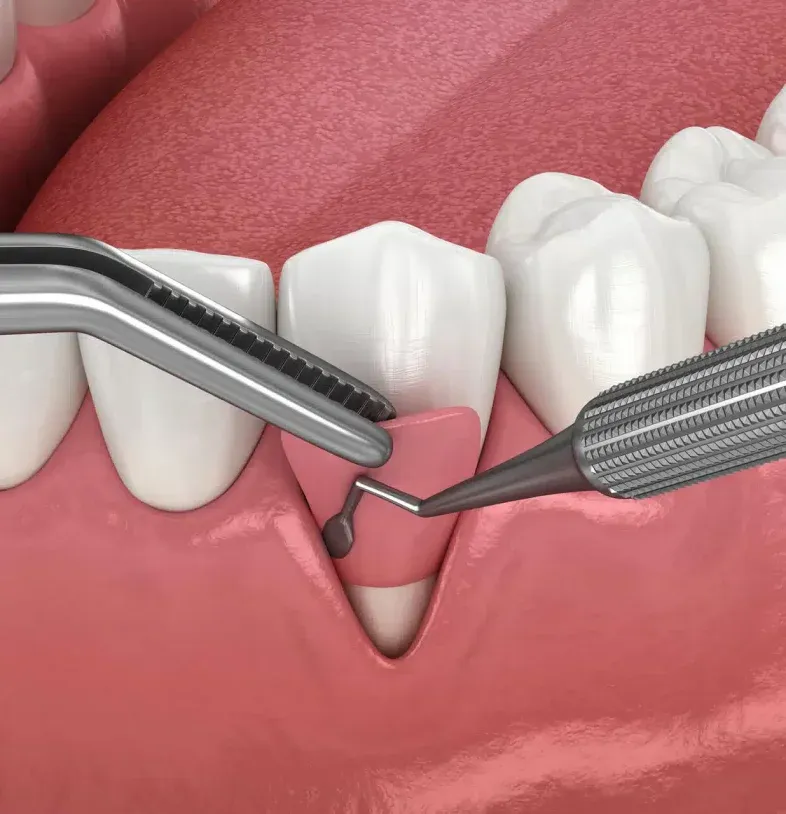

Restore Your Smile with Gum Grafting in North Hollywood Today Experience Precision with Digital X-Rays in North Hollywood
Our gum grafting procedure helps to rebuild and restore the natural appearance of your gums.
What is Gum Grafting: A Proven Solution for Receding Gums
Gum grafting is an effective Receding Gum Treatment in North Hollywood. It is designed to restore lost tissue and improve gum health with gum tissue grafting. Our procedure involves taking tissue from a donor site in your mouth, typically the palate, and grafting it to areas where the gums have receded.
This helps cover exposed tooth roots, reducing sensitivity and protecting against further damage. In addition to improving the aesthetic look of your smile, gum grafting provides long-term oral health benefits. It is a highly effective treatment for those who suffer from advanced gum recession, and they search for periodontist Near me for better solutions.
The Benefits of our Gum Surgery in North Hollywood: A Long-Term Solution to Your Gum Recession
Our gum grafting treatment offers several long-lasting benefits for individuals dealing with gum recession. This procedure not only improves the appearance of your smile but also protects your teeth and gums from further damage, providing a solution for long-term oral health.

Gum Grafting for Gum Recession:
A Vital Step in Preserving Your Oral Health
Gum grafting is an effective solution for addressing gum recession, which can lead to tooth sensitivity and an increased risk of decay. This procedure restores lost gum tissue, protecting the roots of your teeth and preventing further recession.
Gum grafting helps you avoid more serious dental issues by repairing the gum line. It maintains your overall oral health and the appearance of your smile. Choosing our gum grafting offers long-term benefits for your dental health. It can stop the progression of gum recession, protect your teeth from exposure, and reduce the risk of tooth loss.
With the right care, we help you restore both function and aesthetics of your gums. We can help in improving your confidence and comfort. If you are experiencing gum recession, scheduling a consultation can help you understand your treatment options and get the care you need to maintain healthy gums.
Gum grafting addresses the root cause of gum recession and helps restore your gums to their natural state.
Is Gum Grafting Right for You?
Discover more about what makes our gum grafting a right treatment for you.
Affordable Gum Grafting Solutions in North Hollywood
At Studio City Dental Group, we offer affordable gum grafting solutions to address gum recession and restore your gum health. Our team provides high-quality care without the high costs, offering a more accessible approach to gum grafting.
With financing options available, you can get the treatment you need without breaking the bank. If you are experiencing gum recession, we can help you find an affordable solution. Our team will help to improve your oral health and prevent future complications.
Prevent Tooth Loss with Our Gum Grafting Treatment
Gum recession can lead to tooth loss if left untreated which makes gum grafting an essential treatment for many patients. By restoring lost gum tissue, this procedure protects the roots of your teeth and keeps your smile intact.
Delaying treatment can lead to more severe dental problems, so it is important to act quickly. Our affordable gum grafting services provide a proactive way to preserve your oral health and maintain a confident smile for years to come.
Simple Steps to Restore Your Gum Health with Our Dentists
Our gum grafting procedure involves simple, clear steps to restore your gum health. From your initial consultation to post-procedure recovery, we make the process smooth and straightforward, providing the care you need to achieve healthier gums.
Evaluating the damage
During your consultation, we assess the extent of your gum recession and discuss the best options for your needs. This is an important step to determine the right approach for your gum health and long-term goals.
Harvesting Tissue
After the consultation, tissue is either taken from the roof of your mouth or a donor site to replace the gum tissue that has receded. This step is performed under local anesthesia to ensure comfort during the procedure.
Gum Grafting Application
The harvested tissue is carefully applied to the affected area of your gums. The graft is secured in place, promoting the healing process and helping to restore the natural contour of your gum line.
Recovery and Aftercare
Following the procedure, we provide clear aftercare instructions to support healing. Most patients can return to their normal routines within a few days, and we schedule follow-up visits to monitor your recovery and maintain optimal gum health.
Stop gum recession from advancing with our effective gum grafting procedure. By restoring your gum line, we help protect your teeth and prevent further damage. Contact us today to learn how we can help safeguard your oral health.
Take the First Step Toward Restoring Your Gum Health
Ready to restore your gum health? Schedule a consultation today to explore how gum grafting can address recession and protect your smile. Our team is here to guide you through every step of the process, from assessment to recovery to give best Periodontal Care in North Hollywood.
Frequently Asked Questions (FAQs)
Understanding the details of gum grafting is essential for patients considering this treatment. Common questions can help you learn how it helps protect your oral health. These FAQs provide clear insights into procedure.
Patients with gum recession, exposed tooth roots, or those at risk of further gum loss are ideal candidates. A consultation will determine the best course of action based on your oral health needs.

